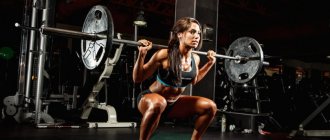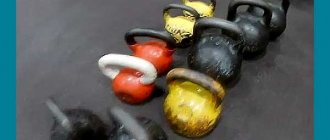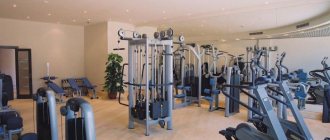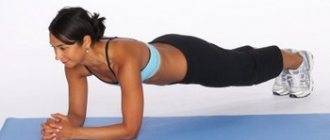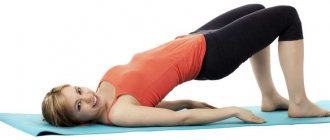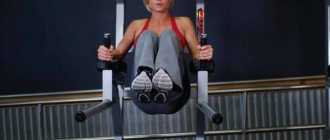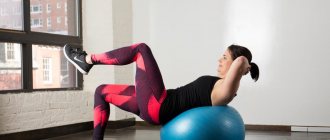Using a kettlebell, you can replace the usual military barbell press technique. In addition, holding and squeezing a kettlebell requires the work of more muscles. Previously, the kettlebell press was part of the mandatory kettlebell lifting triathlon complex. Now this exercise is used separately not only in CrossFit, but also in gyms as an assistant for the development of deltas.
What muscles work when pressing a kettlebell?
First of all, when pressing a kettlebell, the deltoid muscles are activated, especially the anterior bundles. Accessory muscles include: triceps, upper trapezius, rhomboids. In addition to the core muscles, the back and abdominal muscles work during the press, which stabilize the position when lifting the projectile, which does not happen to the same extent with the military barbell press. Like many kettlebell exercises, the bench press develops deep muscles that are not worked by isolation exercises for the deltoids.
The effectiveness of training for weight loss and muscle growth
A set of exercises with kettlebells is highly effective in losing weight and gaining muscle mass. In the course of research conducted by American scientists, it turned out that when performing physical exercises with a weight, a person burns 20 kcal per minute. This is 1200 kcal for 1 hour of training.
Average energy metabolism rates for a girl aged 25-35 years are about 1700-1900 kcal per day. Thus, an hour-long kettlebell workout covers more than half of the calories consumed in one day.
Squats with a kettlebell are one of the mandatory exercises in the complex for the gluteal muscles.
High energy costs during sports activities with weights are due to the intensity of the training process. Most exercises with these athletic equipment involve the development of explosive strength and involve a large number of muscle groups.
Kettlebell training for girls has a pronounced multiplier effect. During a sports activity, not only fast white (oxidative) muscle fibers are included in the work, but also slow (restorative) ones.
Developing both types of muscles in one workout more effectively tones the muscles of the entire body, recovery processes on rest days are more intense, and fat burning occurs faster.
The involvement of two types of muscles (fast and slow) helps to accelerate the strengthening of the muscles of the whole body .
Sets of exercises with weights can give quick results for beginners. This is due to metabolic processes within the body. To contract and perform the task at hand, muscles need energy. It is stored in mitochondria inside cells. In each person's body, their number can vary significantly. This determines the predisposition to a particular sport. It is impossible to determine the predominant type of muscle fiber, and therefore correctly build a training plan, without medical research.
Therefore, beginners need to devote equal amounts of time to anaerobic and aerobic training. Which can lead an unprepared person to overwork. Sets of exercises with kettlebells solve this problem.
Contraindications and precautions
- In case of hernias, protrusions of the spine, or disc displacements, loading with weights is contraindicated.
- If you experience pain in the joints, even when working with light weights, you should wait to do the bench press.
- Do not “break out” your hand; keep your forearm and hand in a straight line.
- Try to perform the press up concentrated, do not jerk. It is important not to confuse the exercise with kettlebell pushes, because they are not performed with the shoulders, but with an impulse due to the power of pushing out the legs.
Important points
To ensure that your training brings only positive results, pay attention to a few simple recommendations:
- Do not allow your wrist to bend or straighten while doing presses. Your wrist is in line with your forearm - this is a necessary condition for the safety of the ligaments and joint.
- Keep your entire body tense as you move. There should be no relaxation in the legs, buttocks or body.
- Don't be fanatic about choosing the weight of the weights. A machine that is too heavy will prevent you from performing the exercise correctly and create a risk of injury. The market offers a huge number of options for dumbbells - for any color and size. Remember that a 32 kg kettlebell press can be done by a trained athlete, but not by a beginner who has not previously engaged in strength sports.
- Pay attention not only to strength exercises, but also to stretching. It will make the muscles and ligaments more elastic, the movements will become cleaner, and the technique will be much easier to master.
- In this exercise, try to avoid jerking. Raise the projectile under control and lower it under control.
Even if you have previously trained your shoulders with dumbbells or a barbell, adding kettlebell lifts to your program will create an unusual load on the muscles, thereby creating an impulse for their growth and increase in strength.
Where to begin?
- Warm up the muscles and joints not only of the shoulder girdle, but of the whole body. Since the kettlebell press is not isolated work of the arms, the muscles of the back and abdomen are involved here, so it is important to avoid injuries by fully warming up.
- Naturally, to begin with, choose a small load weight - from 8 kg. If this weight turns out to be heavy, perform the load with dumbbells or kettlebells of lower weight.
- Having mastered the technique with one hand, proceed to press two kettlebells while standing, also choosing the load correctly.
- Learn the technique of lifting the kettlebell to the starting position. The jerk, or lifting the weight to its original position, happens like this: while bending over with a straight back, grab the handle of the weight, swing back and forth, allowing the weight to fly up. In the middle of the amplitude, bend your elbow and carefully rotate your hand so that the weight rests on your forearm.
- Under no circumstances should you jerk through pain , always keep your back straight, avoid injury to the intervertebral discs and pinched nerve endings.
Standing kettlebell press in training plan
The benefit of the kettlebell press is that it requires concentration and stabilization. It teaches the correct upward pressing movement, and is a lead-in movement to the popular CrossFit pushes, barbell thrusts, and standing presses. It allows you not only to gain upper body muscle mass quickly, but also to develop the neuromuscular connection required for strength training. For women, this exercise will help avoid imbalances in the upper and lower body, and work the center of the body under load, preparing the body for heavy basic movements with a barbell.
The standing kettlebell press should be the first exercise in a beginner athlete's training plan to achieve full concentration on muscle contraction and quickly develop technique.
One-arm kettlebell press technique
- Take the starting position, with your feet slightly wider than your pelvis, grasp the handle of the weight with one hand while bending over, and jerk the weight toward your chest, as indicated above for the precautions.
- Place your elbow close to your body, the kettlebell resting on the side of your forearm, and your hand near the shoulder joint. Keep your other hand loosely to the side.
- Tighten your back and abdominal muscles, keeping your spine straight.
- Exhale as you press up, lifting the weight vertically above your shoulder joint. Turn the hand with the weight away from you.
- Slowly lower the weight down along the same trajectory, do not throw the weight of the load; the movement is accompanied by inhalation.
- Perform the required number of presses, take the weight in your other hand and repeat the same number of times.
After performing the movement, straighten your elbow as if you were dropping a weight. But the release should not be accompanied by a jerk in the joints. Smoothly lower the weight with a straight back.
Exercises with kettlebells for all muscle groups
The famous athlete and trainer Roger Lockridge provided readers with his exercises with weights for all muscle groups. It is this technique that we want to share with you. Lockridge is a trainer with extensive experience, his articles are recognized as one of the best in the World. That is why his opinion is listened to and his methods are used by athletes in various industries.
A little about the technique itself
First of all, it is worth saying that exercises with kettlebells are very difficult. They are not easy for weightlifters. They can be effective both for gaining muscle mass and for burning excess weight.
In addition, working with kettlebells can improve the performance of any athletes, be it bodybuilders. Powerlifters or CrossFitters.
Excursion into history
Nobody knows when the first weight was created or how it happened. But in a museum in Athens there is a 143 kg weight that is believed to be the oldest, used by the ancient Greeks to demonstrate their strength.
People realized that exercises with weights developed strength, so exercises with lifting and throwing weights appeared. In Russia, the kettlebell is one of the most popular equipment for sports.
Why are the weights so different?
When working with dumbbells and barbells, the weight is evenly distributed due to their symmetry.
The center of gravity of the weight is located below its handle. This significantly complicates all exercises. When performing almost all exercises with these apparatuses, not only the arms are involved in the work. But also the body, sometimes even the legs.
Kettlebells allow you to perform isolated exercises or involve almost the entire body in work. The variety of kettlebells allows you to use them not only for working on strength, for gaining muscle mass, but also for burning calories, in aerobics, for performing intense exercises and circuit training.
Kettlebell training for beginners
This four-week kettlebell training program will help you incorporate new exercises into your training. In the first week we will get acquainted with basic movements, in the second week we will study isolated exercises. The third week will be devoted to more difficult exercises. In the final week we will analyze circuit training with weights.
Week 1: Basic Kettlebell Training
We will train 4 days a week. Each day is dedicated to a different exercise. Start with the smallest weight, gradually increase it until it becomes your working weight. Therefore, you will have to sweat and do a lot of repetitions.
Kettlebell swings.
The main exercise involves the hips, which will help in execution. Many athletes make the mistake of pushing the kettlebell with their hands, but this is wrong. You need to push the projectile out with your hips.
Hold the weight with both hands, swing your body and throw the projectile up until it reaches chest level, then it goes down. The exercise resembles a pendulum.
Squats with a kettlebell.
Grab the kettlebell by the handles with both hands and press it to your chest so that it lies tightly. Feet slightly wider than shoulder width, lower down until your buttocks are below your knees. Then rise up sharply and start the exercise again. Such squats pump up the quadriceps very well, due to the fact that the weight is located in the front.
Kettlebell press up.
Hold the kettlebell by the handle with one hand so that the weight rests on your shoulder. Lower yourself into a half-squat position, then rise sharply and throw the weight up. The elbow should not go from the side in this case. A very good exercise for deltoids and thighs.
Kettlebell crunches.
Sit on the floor, legs forward, knees in different directions. Hold the kettlebell by the handles, elbows pointing to the sides, arms not bent. You begin to twist your body in one direction, then in the other. This exercise works the oblique abdominal muscles and tightens the deltoids.
Execution program
Perform these exercises after your main load.
Day 1: Kettlebell swings 2 x 15 with 30 seconds rest between sets.
Day 2: Kettlebell squats 3 to 15 with a 30 second break.
Day 3: kettlebell press up 3 x 20 and 30 seconds pause.
Day 4: Kettlebell Crunches 3 rounds of 30 seconds with a 30 second break between each round.
Week 2: Isolation exercises
This week we will learn new exercises for the lower body, upper body and core. You need to do them after your workout in addition to everything else.
Kettlebell snatch.
The exercise begins like swings, from the same position. But this time the trajectory of the weight will be slightly changed. Take the kettlebell in one hand, use your core and hips to lift it to shoulder level and push up. After this, return to the starting position. The same must be done with the other hand.
Kettlebell row to the stomach.
Take the weight in one hand, bend your back, it is best to rest on the bench with one hand. Now pull the projectile with one hand towards the stomach, while the shoulder blades should close, but the body remains motionless.
Lunges.
Grab the handle of the kettlebell with both hands and press it to your chest, as if you were doing a squat. Now do regular lunges forward or backward, whichever you prefer.
Mill with weights.
Feet shoulder-width apart, weight in one hand. Lift the weight up at arm's length. Task: touch the toe with your free hand without lowering the weight. Therefore, if the kettlebell is in your right hand, then lean to the left slowly, and then slowly rise to the starting position. When you're done, switch hands and lean to the other side.
Execution program
This time we will perform the exercises according to an advanced scheme. We also include movements from last week in the program. We add them as auxiliary ones after the main workout.
Day 1: kettlebell swings, kettlebell presses, kettlebell snatches, kettlebell rows (each exercise 3 x 20, with 30 seconds rest).
Day 2: kettlebell squats, lunges, crunches, mill (3 x 20 for each exercise, 30 seconds break).
Day 3: Kettlebell swing, Kettlebell overhead press, Kettlebell snatch, Kettlebell row (3 x 45 seconds per exercise, 30 seconds rest).
Day 4: Kettlebell squats, lunges, crunches, mill (3 x 45 seconds for each exercise, 30 seconds rest).
Week 3: Advanced Kettlebell Exercises
You have already become familiar with various exercises and learned to feel which muscles work during training. It's time to move on to more interesting options that you can do after your workouts.
Rising in Turkish.
The exercise begins in a prone position with the weight hanging in the air at a 45-degree angle to your body. You hold it by the handle at arm's length. Task: get up and lie down again, without dropping the weight.
First, place one foot on the floor and lift your upper body. Then place your free hand on the floor and rise up onto 2 legs. To lie down, perform the steps in reverse order. This training develops various muscle groups.
Throwing a weight to the chest.
Feet wider than shoulder width, hold the weight by the handles, it hangs between your legs. Rock your body and throw the weight up. When she reaches chest level, we grab her with our hands and press her to ourselves. Then we return to the starting position.
Dumbbell push-ups with abdominal thrusts.
We place the weights on the floor shoulder-width apart, rest them on the handles and perform push-ups. After each repetition, pull the weight towards your stomach and place it back on the floor. This exercise combines 2 movements at once, therefore it is more difficult and effective.
Kettlebell rotations.
Get down on one knee. Take the weight by the handle and lift it to head level. The body remains motionless during the exercise. Now rotate the kettlebell around your head, transferring the weight from one shoulder to the other.
Execution program
Day 1: perform each exercise 3 x 10, with a rest of 30 seconds.
Day 2: perform each exercise 3 x 20, with a rest of 30 seconds. The next day we take a break from weights.
Day 3: perform each exercise 3 x 10, with a rest of 30 seconds.
Day 4: perform each exercise 3 x 20, with a rest of 30 seconds.
Week 4: Kettlebell Circuit Training
This week we will combine all the exercises into a circuit training session. As you get used to them, you can add more sets or reps and decrease the rest. Include all the basic movements in the program and add those exercises that you are good at.
Execution program
Day 1: perform the exercises sequentially, 30 seconds each. At the end, rest for 60 seconds and start again, 3 such circles.
Day 2: perform the exercises sequentially, 45 seconds each. At the end, rest for 60 seconds and start again, 3 such circles.
Day 3: perform the exercises sequentially, 60 seconds each. At the end, rest for 45 seconds and start again, 3 such circles.
Day 4: perform the exercises sequentially, 60 seconds each. At the end, rest for 30 seconds and start again, 3 such circles.
FOLLOW NEWS AND TRAINING PROGRAMS IN OUR YANDEX ZEN CHANNEL.
crossfit, cardio, Exercises
Double kettlebell press technique
- Place two weights together, stand in front of them with your feet slightly wider than your pelvis in a stable position.
- Bend over and grab the arms, throw two weights to the starting position - weights at the shoulder, elbows pressed as close as possible to the body.
- As you exhale, press both weights up above your shoulders without leaning your body back .
- As you inhale, lower the weights to the starting point.
- Complete the set and gently release the weights without jerking and lower them to the floor.
Important! Perform the technique on straight legs, do not squat when pushing out the weights. Remember that the exercise is done in a concentrated manner, try to isolate your shoulders from the help of your pelvis and legs.
How to choose kettlebells
When choosing a kettlebell for training, the main focus should be on the handle. It should be of optimal diameter and the hand should clasp it securely. This is especially true for girls. Also, the handle of the kettlebell should have a length slightly greater than the grip width of both hands.
The material from which the main body of the weight is made is not of fundamental importance. For fitness, this sports equipment is made of plastic; the cast iron core is covered with a rubber shell or a layer of enamel. The shape and color of the material do not affect the functionality of the weight.
There is a wide selection of weights for girls. Their mass differs depending on the type of training and sport:
| For beginners and girls who use weights for the first time in the training process | 6 kg |
| For girls who lead an active lifestyle and regularly play sports | 8 kg |
| For advanced users | 12 kg |
